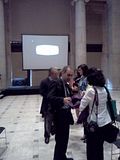Monday evening I ended my
Bayreuth Festival experience at the new production of
Götterdämmerung. Its huge rotating unit set, taller than the stage, is impressive. There are sidewalks, many stairs, a huge neon sign for an East German chemical company, & a huge wrapped facade which is revealed to be the New York Stock Exchange. We also see videos, some shot live by cameramen on stage with the performers.
Castorf's staging is a collection of gestures with no follow-through & no relationship to the libretto. Brünnhilde gives Siegfried a stuffed animal for his Rhine journey, then he sleeps in a fetal position during the scene transition. The motel attendant from
Rheingold appears again. He falls down stairs, gets punched in the face & noisily spills a baby carriage full of potatoes down a staircase during the revenge trio. The audience gasped when the opening of act 3 showed the Rhinemaidens had callously run him over in their car. In the immolation scene Brünnhilde splashes gasoline on the set & the Rhinemaidens hold out lighters, but the set rotates the tableaux out of sight, & no hint of a conflagration of any kind of catastrophe occurs.
The chorus sounded terrific in act 2, singing as one & creating a powerful wall of sound. The horn calls coming from the sides of the stage at the beginning of their scene were eerie & thrilling. As Brünnhilde, soprano
Catherine Foster had easily soaring high notes, though her low notes sometimes disappeared. Tenor
Lance Ryan as Siegfried had an unpredictable voice, sometimes sounding fine, at other times less clean, but he moves athletically & communicates youthful energy. He used a strange falsetto when singing the Forest Bird's music in act 3.
Mezzo
Claudia Mahnke did double duty as a Norn & a distraught Waltraute, her singing radiant & nicely connected. The staging for the Waltraute scene was effective & engaging, since the characters sang to each other & interacted like real sisters.
Baritone
Alejandro Marco-Buhrmester had a muscular voice & his Gunther had a strong characterization as a tough urban immigrant running a döner stand. He looked handsome even in video close-ups. Bass
Attila Jun, sporting a spiky mohawk, was a stolid & heavy-voiced Hagen. Siegfried's Funeral March is accompanied by a video of him walking through a forest pensively, but the sheet lowered as a screen for the video caught on something & did not unfurl properly. Soprano
Allison Oakes was an out-going & fun-loving Gutrune. Bass-baritone
Martin Winkler distractingly wore no pants during Hagen's dream.
Something must have gone wrong with the horn solo in Siegfried's Rhine Journey, since it sounded recessed & barely audible. The horn call at the beginning of act 3 rang out vividly, however. Conductor
Kirill Petrenko has led a humane
Ring with a supple & transparent texture. The music flowed lightly without rough edges or pushing up to big climaxes. I loved the way Siegfried's Funeral March lingered over the quiet scene for Gutrune that followed.
Surprisingly there were almost no boos, though there was a brief protest after the house lights went up. The cast took curtain calls after each act, & the final curtain call lasted under 10 minutes. Maestro Petronko received the loudest ovation, & Mr. Ryan received some boos. The production is an embarrassment for the festival, especially since there were so many elements there to make it a great
Ring.
Perhaps because they knew this was their last chance, attendees were more brazen in taking photographs of
Die Oper Tratscherin. Her glittery pink dress had pictures of cupcakes, ice cream & rainbows, which she interpreted as a depiction of an apocalypse. There was a heavy rainstorm before the performance, & I got soaked on the walk to the Festspielhaus, even with the help of Die Tratscherin's umbrella. We discovered that in case of rain, the brass band plays the pre-act fanfares in the doorway beneath their usual balcony.
The evening felt too short. Even though it seems a long time since I saw the lab rat
Lohengrin, I'm stunned that my Bayreuth visit is already over.
§ Götterdämmerung
Bayreuther Festspiele 2013
Conductor, Kirill Petrenko
Director, Frank Castorf
Stage design, Aleksandar Denić
Costumes, Adriana Braga Peretzki
Lighting, Rainer Casper
Video, Andreas Deinert & Jens Crull
Choral Conducting, Eberhard Friedrich
Siegfried, Lance Ryan
Gunther, Alejandro Marco-Buhrmester
Alberich, Martin Winkler
Hagen, Attila Jun
Brünnhilde, Catherine Foster
Gutrune, Allison Oakes
Waltraute, Claudia Mahnke
1. Norn, Okka von der Damerau
2. Norn, Claudia Mahnke
3. Norn, Christiane Kohl
Woglinde, Mirella Hagen
Wellgunde, Julia Rutigliano
Floßhilde, Okka von der Damerau
Montag 19. August, 04:00 PM
 Thursday night I was at the Cartoon Art Museum for Thinking Captions, a comics reading & kick-off event for the SF Zine Fest, taking place this weekend in Golden Gate Park. 5 zinesters presented slides & read to a lively audience of fans. The event was frequently interactive. Emily Alden Foster enlisted an audience member in a game that generates random ingredients for a soda & came up with a recipe combining soda water, brown sugar & electricity. Sophia Foster-Dimino's diagrammatic comics are elliptical stories that are completed in the mind of the reader. Roman Muradov planted a heckler in the audience to make his comics even more whimsical & surreal. Many marvelled at his skillful drawing, lettering & use of ink washes. Mr. Muradov is shy, bearded & bespectacled & looks a bit like a cartooon himself.
Thursday night I was at the Cartoon Art Museum for Thinking Captions, a comics reading & kick-off event for the SF Zine Fest, taking place this weekend in Golden Gate Park. 5 zinesters presented slides & read to a lively audience of fans. The event was frequently interactive. Emily Alden Foster enlisted an audience member in a game that generates random ingredients for a soda & came up with a recipe combining soda water, brown sugar & electricity. Sophia Foster-Dimino's diagrammatic comics are elliptical stories that are completed in the mind of the reader. Roman Muradov planted a heckler in the audience to make his comics even more whimsical & surreal. Many marvelled at his skillful drawing, lettering & use of ink washes. Mr. Muradov is shy, bearded & bespectacled & looks a bit like a cartooon himself. Ric Carrasquillo shared a hip & irreverent story inspired by watching too many episodes of The West Wing. He narrated in an appropriately deadpan voice & was accompanied by a double bass player's smooth, pizzicato improvisation. Justin Hall made sure there were no children in the audience before launching into his extremely silly mash-up of the myth of Orpheus, featuring Freddie Mercury as the Queen of Gaydes. Mr. Hall read the dialogue with flair but was booed mercilessly when he refused to sing the lyrics to "Can't help lovin' dat man of mine."
Ric Carrasquillo shared a hip & irreverent story inspired by watching too many episodes of The West Wing. He narrated in an appropriately deadpan voice & was accompanied by a double bass player's smooth, pizzicato improvisation. Justin Hall made sure there were no children in the audience before launching into his extremely silly mash-up of the myth of Orpheus, featuring Freddie Mercury as the Queen of Gaydes. Mr. Hall read the dialogue with flair but was booed mercilessly when he refused to sing the lyrics to "Can't help lovin' dat man of mine."
















































